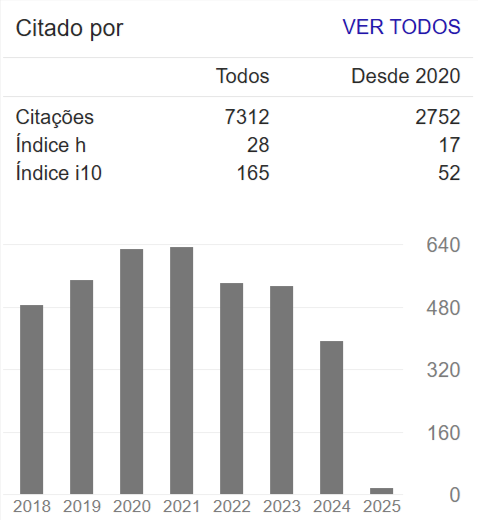Evaluation of sodium persulfate transport injected in monitoring wells with screen in two hydrostratigraphic layers in a contaminated area
Abstract
Hydrostratigraphic heterogeneities can limit the success of remediation projects. The present study aimed to evaluate in the field, on a detailed scale, the reach of sodium persulfate when injected through wells with filter sections of 1.0 meter intercepting hydrostratigraphic units of different hydraulic conductivities, in an aquifer with the presence of organochlorines contaminants in the district of Jurubatuba, in the city of São Paulo. The filter sections of the injection wells intercepted layers of fine to medium graded sand, with little silty, and a layer of coarse sand of varied granulometry with the presence of boulders. The monitoring of the persulfate flow in these different layers was done by collecting groundwater with a bailer liquid sampler followed by measurements of parameters indicative of the presence of persulfate. Measurements of electrical conductivity, pH and concentration of persulfate in the wells were performed in loco with a conductivity meter, benchtop pH meter and Klozur® Field Test Kits, respectively, and the concentration of contaminants through laboratory analysis. The results of these measurements showed that the persulfate flux was concentrated at the base of the layer of coarse sand of varying granulation with the presence of boulders, which may be an indication that hydrogeological heterogeneities form preferential paths. This fact should be considered in remediations with persulfate injection, to save resources and better sizing the system.
References
BLOCK, P. A.; BROWN, R. A.; ROBINSON, D. Novas Tecnologias de Ativação para Oxidação Química In Situ com Persulfato de Sódio. Águas Subterrâneas, [S. l.], v. 1, 2009. Disponível em:
https://aguassubterraneas.abas.org/asubterraneas/article/view/22094. Acesso em: 13 out. 2022.
CETESB (COMPANHIA AMBIENTAL DO ESTADO DE SÃO PAULO) . Manual de gerenciamento de áreas contaminadas. 3.ed. São Paulo, 2021. Disponível em:
https://cetesb.sp.gov.br/areas-contaminadas/documentacao/manual-de-gerenciamento-de-areas-contaminadas/introducao-ao-gerenciamento-de-areas-contaminadas/conceituacao/ . Acesso em: 13 out. 2022.
CRIMI, M. L.; TAYLOR, J. Experimental evaluation of catalyzed hydrogen peroxide and sodium persulfate for destruction of BTEX contaminants. Soil and Sediment Contamination: an international, v. 16, n. 1, p. 29–45, 2007. https://doi.org/10.1080/15320380601077792
DAHMANI, M.A.; HUANG, K.; HOAG, G. E. Sodium Persulfate Oxidation for the Remediation of Chlorinated Solvents (USEPA Superfund Innovative Technology Evaluation Program). Water Air Soil Pollut: Focus, v. 6, n. 1-2, p. 127–141, 2006. https://doi.org/10.1007/s11267-005-9002-5
FETTER, C.W. Contaminant Hidrogeology. New Jersey: Prentice-Hall, 4th edition, 2001. 615 p.
GEOSAMPA. Prefeitura Municipal de São Paulo. 2022. Disponível em: http://geosampa.prefeitura.sp.gov.br/PaginasPublicas/_SBC.aspx#. Acesso em: 9 out. 2022.
GUILBEAULT, M. A.; PARKER, B. L., CHERRY, J. A. Mass and Flux Distributions from DNAPL Zones in Sandy Aquifers. Groundwater, v. 43, n. 1, p. 70-86, 2005. https://doi.org/10.1111/j.1745-6584.2005.tb02287.x
GUO, J.; GAO, Q.; YANG, S.; ZHENG, F.; DU, B.; WEN, S.; WANG, D. Degradation of pyrene in contaminated water and soil by Fe2+-activated persulfate oxidation: Performance, kinetics, and background electrolytes (Cl-, HCO3- and humic acid) effects. Process Safety and Environmental Protection, v. 146, p. 686-693, 2021.
https://doi.org/10.1016/j.psep.2020.12.003
ITRC (INTERSTATE TECHNOLOGY & REGULATORY COUNCIL). Technical and regulatory guidance for in situ chemical oxidation of contaminated soil and groundwater. 2 ed. ISCO-2. Washington, D.C.: Interstate Technology & Regulatory Council, In Situ Chemical Oxidation Team. 2005. Disponível em:
https://clu-in.org/download/contaminantfocus/pcb/isco-2.pdf. Acesso em: 21 abr. 2021.
KOLTERMANN, C. E.; GORELICK, S.M. Heterogeneity in sedimentary deposits: A review of structure-imitating, process-imitating, and descriptive approaches. Water Resources Research, v. 32, n. 9, p. 2617-2658, 1996. https://doi.org/10.1029/96WR00025
KULKARNI, P. R.; GODWIN, W. R.; LONG, J. A.; NEWELL, R. C.; NEWELL, C. J. How much heterogeneity? Flow versus area from a big data perspective. Remediation, v. 30, n. 2, p. 15-23, 2020. https://doi.org/10.1002/rem.21639
LIANG, C.; BRUELL, C. J., MARLEY, M. C.; SPERRY, K. L. Persulfate oxidation for in situ remediation of TCE. II. Activated by chelated ferrous ion. Chemosphere, v. 55, n. 9. p. 1225–1233, 2004a. https://doi.org/10.1016/j.chemosphere.2004.01.030
LIANG, C.; BRUELL, C. J.; MARLEY, M. C.; SPERRY, K. L. Persulfate oxidation for in situ remediation of TCE. I. Activated by ferrous ion with and without a persulfate-thiosulfate redox couple. Chemosphere, v. 55, n. 9, p. 1213–1223, 2004b.
https://doi.org/10.1016/j.chemosphere.2004.01.029
LIANG, C.; GUO, YY. Remediation of Diesel-Contaminated Soils Using Persulfate Under Alkaline Condition. Water, Air, & Soil Pollution, v. 223, n. 7, p. 4605–4614, 2012. https://doi.org/10.1007/s11270-012-1221-6
MCCARTY, P. L. Groundwater contamination by chlorinated solvents: History, remediation technologies and strategies. In: STROO, H. F., WARD, C. H. (Eds). In Situ Remediation of Chlorinated Solvent Plumes. New York: Springer, 2010; p. 1-28. https://doi.org/10.1007/978-1-4419-1401-9_1
PARKER, B.L.; CHAPMAN, S.W.; GUILBEAULT, M. A. Plume persistence caused by back diffusion from thin clay layers in a sand aquifer following TCE source-zone hydraulic isolation. Journal of Contaminant Hydrology, v. 102, n. 1-2, p. 86–104, 2008. https://doi.org/10.1016/j.jconhyd.2008.07.003
PAYNE, F.C.; QUINNAN, J. A.; POTTER, S. T. Remediation Hydraulics. Florida-USA: CRC Press. Boca Raton, 2008. 416p.
PELUFFO M.; PARDO F.; SANTOS, A.; ROMERO, A. Use of different kinds of persulfate activation with iron for the remediation of a PAH-contaminated soil. Science of The Total Environment, v. 563–564, p. 649-656, 2016. https://doi.org/10.1016/j.scitotenv.2015.09.034
PEROXYCHEM. Klozur® Field Test Kits: Technical Data Sheet. 2014. Disponível em:
https://www.peroxychem.com.br/media/116783/peroxychem-klozur-field-test-kit-tds.pdf
Acesso em: 21 abr. 2021.
RICCOMINI, C.; COIMBRA, A. M. Geologia da bacia sedimentar. Solos da Cidade de Sao Paulo. Tradução . São Paulo: Abms/Abef, 1992.
RIYIS, M. T.; ARAKAKI, E.; RIYIS, M. T.; GIACHETI, H. L. A importância da amostragem de solo de perfil completo (ASPC) para a investigação de alta resolução em áreas contaminadas. Águas Subterrâneas, v. 33, n. 4, 2019. https://doi.org/10.14295/ras.v33i4.29735
SCHULTZ, M. R., CRAMER, R. S., PLANK, C., LEVINE, H., & EHMAN, K. D. Best Practices for Environmental Site Management: A practical guide for applying environmental sequence stratigraphy to improve conceptual site models. U.S. Environmental Protection Agency. Washington, DC, EPA/600/R-17/293, 2017. 62 p.
SIMONATO, M.; WENDLAND, E.; HIRATA, R.; SOUZA, L. C.; L’APICCIRELLA, E. Projeto Jurubatuba - Restrição e controle de uso de água subterrânea. Departamento de Águas e Energia Elétrica, Instituto Geológico. São Paulo, 2009. 110 p.
STROO, H. F.; LEESON, A.; MARQUSEE, J. A.; JOHNSON, P. C.; WARD, C. H.; KAVANAUGH, M. C.; SALE, T. C.; NEWELL, C. J.; PENNELL, K. D.; LEBRÓN, C. A.; UNGER, M. Chlorinated ethene source remediation: lessons learned. Environmental Science & Technology, v. 46, n.12, p. 6438-6447, 2012. https://doi.org/10.1021/es204714w
SUTHERSAN, S.; DIVINE, C.; COHEN, E.; HEINZ, K. Tracer testing: recommended best practice for design and optimization of in situ remediation systems. Groundwater Monitoring & Remediation, v. 34, n. 3, p. 33 – 40, 2014.
https://doi.org/10.1111/gwmr.12066
TERAMOTO, E. H.; CHANG, H. K.; CAETANO-CHANG, M. R. Transporte de solutos em diferentes cenários geológicos gerados por modelos estocásticos de cadeias de Markov. Águas Subterrâneas, v. 31, n. 4, p. 316–326, 2017. https://doi.org/10.14295/ras.v31i4.28860
TSITONAKI, A.; PETRI, B.; CRIMI, M.; MOSBAK, H.; SIEGRIST, R. L.; BJERG, P. L. In situ chemical oxidation of contaminated soil and groundwater using persulfate: a review. Critical Reviews in Environmental Science Technology, v. 40, n.1, p. 55-91, 2010.
https://doi.org/10.1080/10643380802039303
VILAS BOAS DELGADO, A.; CARDOSO, D.; DE OLIVEIRA, E. Observação de efeitos de densidade na solução oxidante de persulfato de sódio em aquífero intergranular e aquífero fraturado contaminado por etenos clorados. Águas Subterrâneas, [S. l.], 2012. Disponível em: https://aguassubterraneas.abas.org/asubterraneas/article/view/27571. Acesso em: 13 out. 2022.
WEISSMANN, G. S.; FOGG, G. E. Multi-scale alluvial fan heterogeneity modeled with transition probability geostatistics in a sequence stratigraphic framework. Journal Hydrology, v. 226, n. 1-2, p. 48-65, 1999.

















